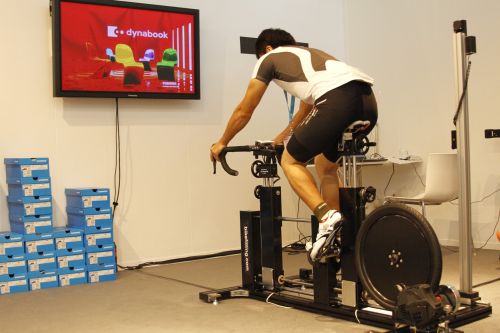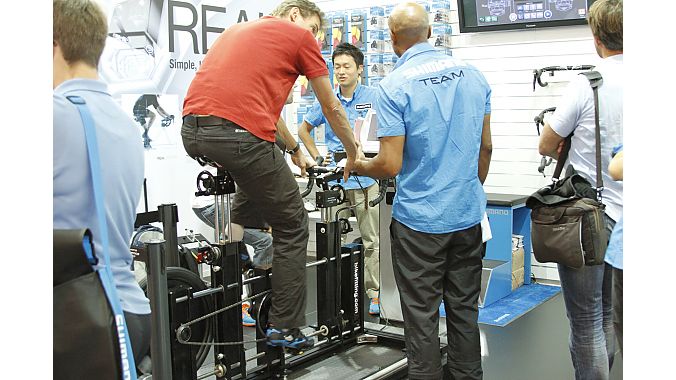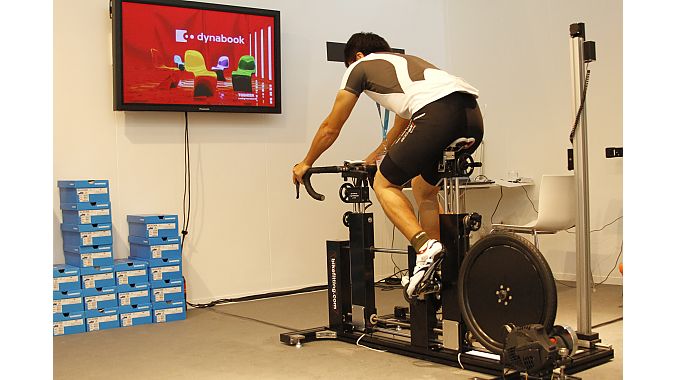FRIEDRICHSHAFEN, Germany (BRAIN) — Almost a year and a half since Shimano acquired Dutch company BikeFitting.com, the components giant gave a peek at its upcoming fitting system at Eurobike.
Set to begin rolling out at the end of the year, the system, which consists of a static measurement jig, position simulator and 3D motion analyzer, will enable dealers to take various measurements to help riders achieve a final comfortable and performance-enhanced position on the bike.
The system is equipped with a crank that measures the power output of the left and right pedal independently and presents the information in a unique graphic user interface.
“As you pedal it immediately starts reacting on the screen,” said Lloyd Thomas, who has worked with ProTour-level teams testing early prototypes. “What it gives me is left and right balance of power and direction so we can fine tune the fore and aft position of the seat, we can look at cleat placement, seat height, but we can also look at the stability of the foot.”
The position simulator allows for precise adjustment and features a quick-release seatpost and handlebar clamp. It has an integrated 3D pedaling analyzer and XY copy tool. “Wizard” and “advance” modes in the 3D motion analyzer take into account a rider’s range of motion, flexibility and riding style during the fit process.
Lloyd said the tool’s development, which took two years, required a huge investment. And Shimano’s shoes are based on information they learned from the fit system and the technology used.
“Ultimately, we want to empower the dealer to sell more bike parts,” Thomas said. “Our challenge is there are a lot of systems out there. The fit market in the States is more developed than in the rest of the world, and really competitive.”
However, one of the advantages he said the Shimano system offers is brand neutrality. Most fitting tools on the market were developed by a specific bike maker or brand, he said. “We wanted to create a situation where a retailer can look at a wall and fill it with parts—from Shimano or another brand—and create a sustainable model for their business that won’t be affected by the Internet. I think all these tools combined achieve that.”
Data gathered could translate into sales of insoles, shims, pedals, shoes, stems, bars or saddles, and in some cases, a bicycle. The software and datasets are based on impression data from bikefitting.com and existing industry fit philosophies, guidelines and best practices.
It’s not cheap, however. The system will set a retailer back around 20,000 euros ($26,600) — 6,000 to 7,000 for the position simulator with power-measuring crankset, 10,000 euros for the motion analysis camera and another 1,000 for the static jig. Lloyd said that while that may sound expensive, it’s hardly the priciest system on the market.
“The initial investment for the dealer sounds like an overwhelming number, but it gives a lot of power to the dealer to say no, ‘This is what you need, not that,’ ” Thomas said.
Using this system, a fit will take on average 1.5 hours, though that can vary depending on the problem that needs to be addressed and the skill level of a dealer.
Thomas said that the position simulator should become available at worldwide retailers worldwide by the end of the year, while the 3D motion analyzer is expected to come to market by the end of the first quarter. Shimano plans to provide dealer training for the fit system, but it’s too early to say how or what that will involve.
Since the position simulator includes a crank arm with strain gauges that measure power, Shimano could potentially sell that product separately in the not so distant future.
“The power market is the next thing Shimano is eyeing,” Thomas said. “It’s always been on the radar. It’s coming, but there are a few hurdles we want to make sure we tackle properly. We want to make sure when it comes out, it really comes out and doesn’t get pulled off the shelf.
“At Shimano, we’re happy to be slow and methodical, because when we bring something out, it’s really good,” he added.






